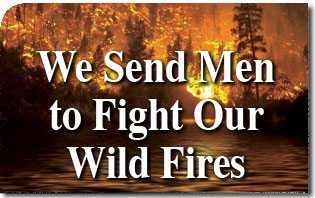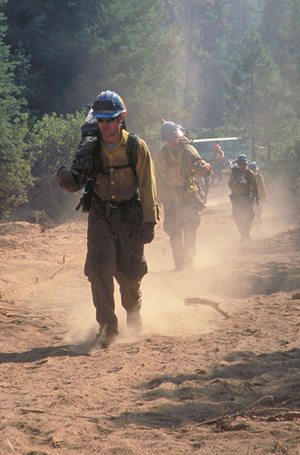 The tragic deaths of nineteen firefighters at a runaway fire in Arizona has led all Americans to rightly honor these brave men as heroes. These fine individuals were a part of a group of firefighters known as the Interagency Hotshot Crew (IHC) or simply, the Hotshot Crew.
The tragic deaths of nineteen firefighters at a runaway fire in Arizona has led all Americans to rightly honor these brave men as heroes. These fine individuals were a part of a group of firefighters known as the Interagency Hotshot Crew (IHC) or simply, the Hotshot Crew.
Similar to our military’s special forces, each Hotshot crew is comprised of 20 men that are highly trained in wildfire suppression techniques and are the elite of wildland firemen due to their high physical fitness standards, extensive training and ability to undertake difficult, dangerous and stressful assignments. They are trained to fight high priority and large fires in isolated areas with minimal logistical support. Hotshot crews respond to more than fires, they assist in other emergencies that include disaster response and search and rescue.
Their origin dates back to the 1940s in Southern California where the Hotshots were those who were assigned to fight the hottest and most dangerous part of the fire. Until the 1930s, firefighting crews were simply assembled as needed until the idea of training and forming an elite force was conceived. They now rival the extraordinary mental and physical training of the military’s special forces. Although sans rifles and incendiary devices, these men work in theatres that are equally harrowing and one’s performance can make or break a dire situation.
 Life as a Hotshot is anything but glamorous. While on assignment a Hotshot’s life is known to be quite primitive. Fresh food, home cooked meals, comfortable beds, entertainment and regular showers are not what one signs up for. A common workday averages 16 hours but can run as long as 64 hours with sleep deprivation a frequent companion and all of this might extend for several weeks. If this does not inspire you to sign up perhaps the incessant exposure to smoke, dust, extreme temperatures and a sundry collection of other environmental hazards offered by a hostile terrain might be more enticing.
Life as a Hotshot is anything but glamorous. While on assignment a Hotshot’s life is known to be quite primitive. Fresh food, home cooked meals, comfortable beds, entertainment and regular showers are not what one signs up for. A common workday averages 16 hours but can run as long as 64 hours with sleep deprivation a frequent companion and all of this might extend for several weeks. If this does not inspire you to sign up perhaps the incessant exposure to smoke, dust, extreme temperatures and a sundry collection of other environmental hazards offered by a hostile terrain might be more enticing.
Physical training is fundamental to a Hotshots performance in the fight. The minimum requirement consists of completing a three mile hike carrying a 45 pound pack in under 45 minutes, a 1.5 mile run in 10:35 or less, 30 plus push-ups in 60 seconds, 45 plus sit-ups in 60 seconds and seven pull ups all completed consecutively.
What do Hotshots call home while battling a raging wildland fire? A small vehicle called a Crew Haul, Crummy, Buggy or just, The Box. This vehicle is the only logistical support a Hotshot has to remain self sufficient for several days. It is the sole transportation and carrier of equipment. Do not expect to see any embedded reporters or Hollywood filming done on location anytime soon.
All Americans join together in honoring these brave individuals and think it logical that they be employed in fighting the nation’s fires. However, one obvious fact is overlooked when reviewing the tragic list of fallen heroes. They were all men.
Fire is a cruel enemy and spares no one who appears in its path. Fire is not politically correct or given to making exceptions to those physically unable to withstand the grueling requirements needed to give battle. It is not only right, but necessary that the most capable be employed to fight this cruel enemy.
And yet… a far crueler enemy to man is another man who not only uses natural strength and endurance capacities but also intellect and cunning to destroy and annihilate those who oppose him on the battlefield. Every advantage must be exploited if the battle is to be won, and lives are needlessly lost if it is not.
This begs the question: Why do we send men to fight our fires and send our women into combat to fight our wars?

